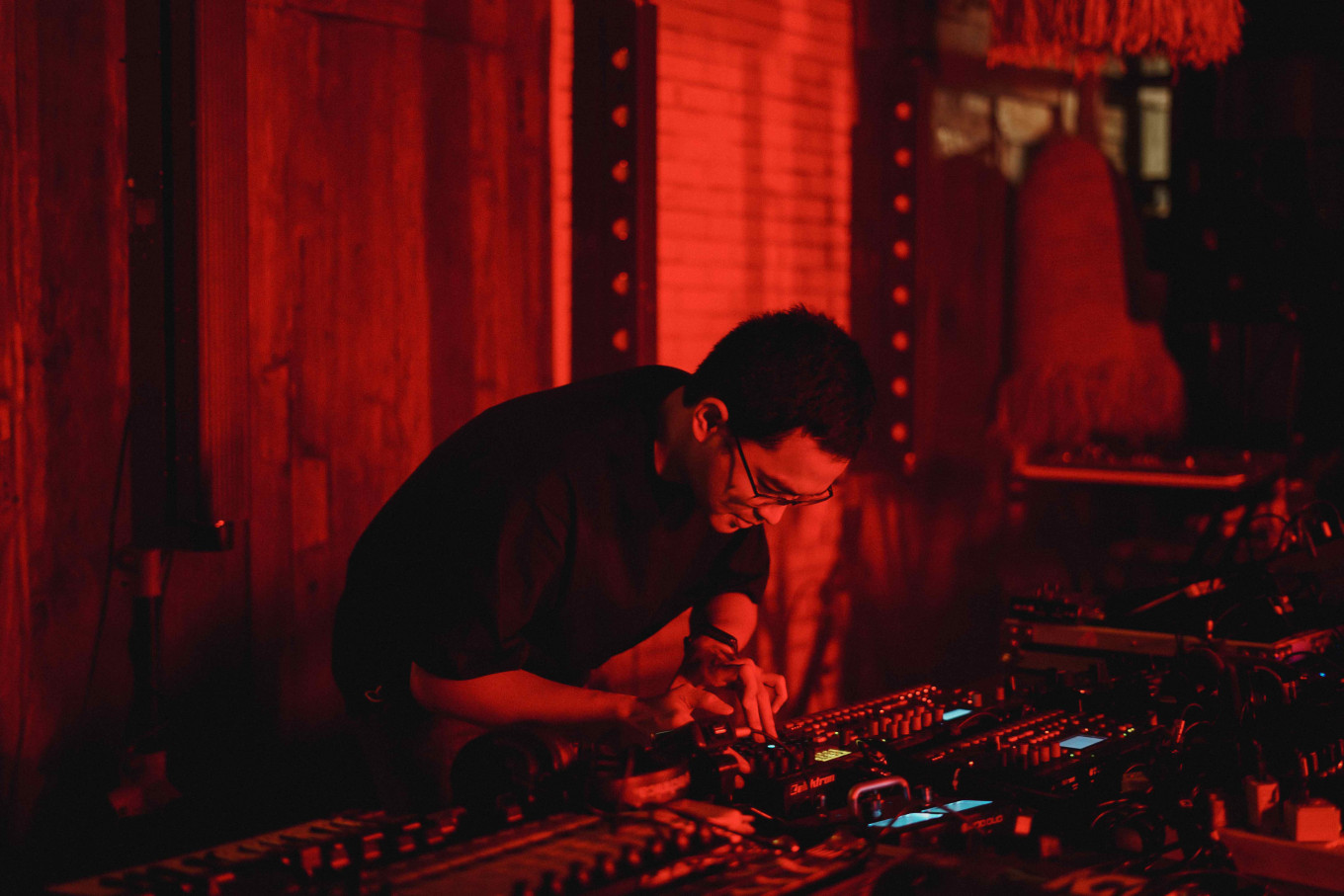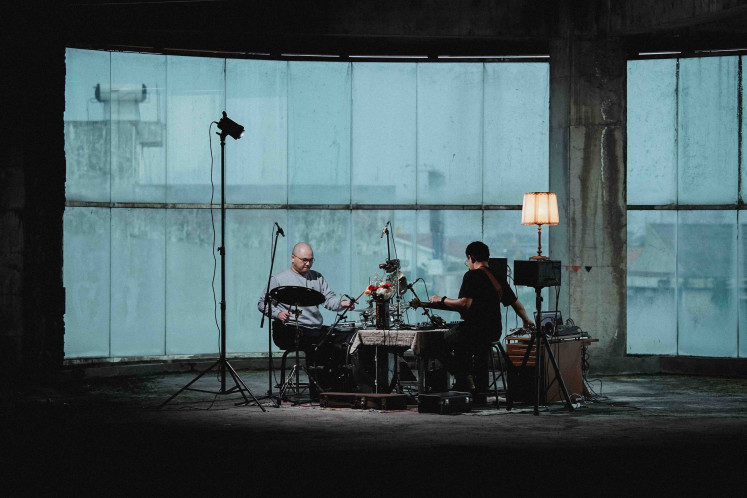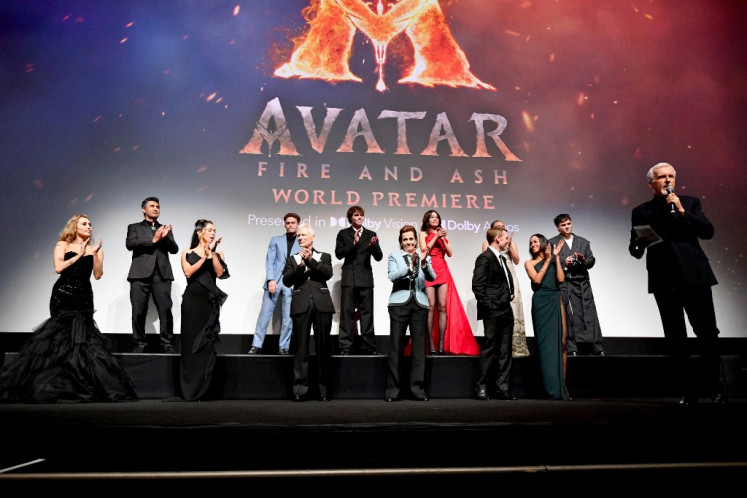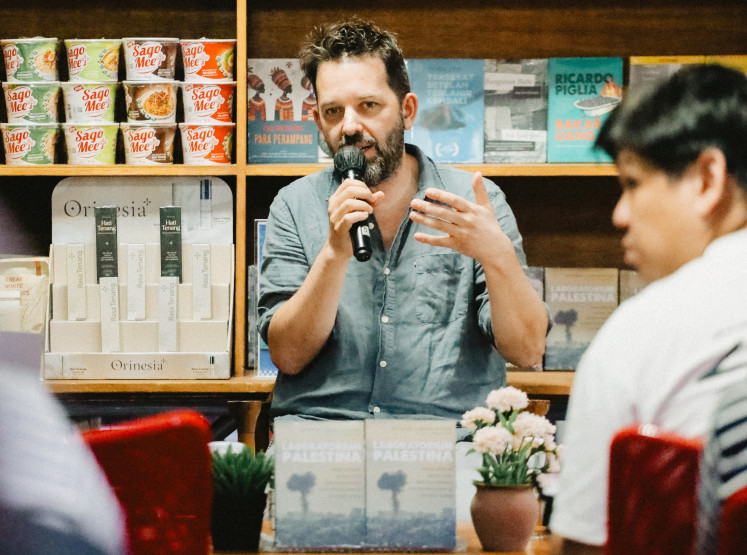Popular Reads
Top Results
Can't find what you're looking for?
View all search resultsPopular Reads
Top Results
Can't find what you're looking for?
View all search resultsKUNTARI continues to stand out with new album
Bandung experimental act KUNTARI/Tesla Manaf tells the story behind his third studio album.
Change text size
Gift Premium Articles
to Anyone
Bandung experimental act KUNTARI/ Tesla Manaf tells the story behind his third studio album.
A little over four years ago, Bandung-based then-jazz musician Tesla Manaf from West Java decided to hang up his guitar and made a fiendishly brave move toward a more left-field nature for his music. Ultimately relinquishing his achievements in the Indonesian jazz scene, he then ventured onto another that was filled with drum machines, noise boxes and synthesizers.
Tesla started producing mordantly-erratic breakcore compositions and managed to release an album, FLEX (released in 2018), before going for a completely clean slate by taking on a new moniker: KUNTARI.
Now, KUNTARI is on its third studio album, Larynx, partnering up with Yogyakarta-based independent record label standing at the forefront of what the uninitiated mostly refer to as “experimental music” in Indonesia, Yes No Wave Music.
While the album itself felt more stripped-down compared to KUNTARI’s previous studio album (Last Boy Picked), it felt heavier and primordial in its truest sense.
A return to the acoustics
“I think I did Larynx with almost no effort,” Tesla told The Jakarta Post regarding his latest album at his studio in Awiligar, Bandung.
“I didn’t mean it in a pompous way, but I’m practically going back to acoustic and analogue instruments [for the album]. That’s something that I consider very natural for me.”
He conceded that working on electronic-based compositions had always been significantly harder for him.
“But what I really like about it is the fact that I didn’t press any guitar strings [for notes in the album]. I was no longer shackled by [musical] tones.”
His statement urged a short recollection back to when he stepped out of the technical jazz and classical music world. He was making a stand against the confines of his own music, and his work in Larynx was one of the victories that he was looking for.
The album had culminated in Tesla’s head for two years, and one of the sparks that started it was Palmer Keen’s field recording project of rhythms and music that he came across throughout Indonesia, Aural Archipelago.
“A lot of weird rhythms that you can find in there. I was really hooked,” Tesla said. He started gathering the instruments relevant to his then-coming project after that.
“It took me forever to get these gongs, I found the one with the right pitch in Berlin,” said Tesla as he pointed toward his set.
A pair of Chau Gongs, one of them larger than the other, were suspended in between a set-of-three roto toms and a set-of-three cowbells. Right next to them was a bass drum, with its front drumhead stripped off. There was a patch of black tape covering something resembling a coin on the remaining head.
The gongs’ pitch and shimmers and the roto toms that were deliberately tuned for a less sustained sound were the key elements in Larynx along with Tesla’s percussive approach in his guitar playing — which was achieved through crossing a set of thicker baritone strings.
The eager drummer: Rio Abror (left) during KUNTARI's video shoot for "Larynx", in February. Rio has been Tesla's drummer and close companion since Tesla's jazz days. (Andi Juhari/Tropis Creative) (Andi Juhari/Tropis Creative)Composing for two
“It did start from the sound, but Last Boy Picked also gave a significant reason for it because it was logistically impossible for me to bring the album’s materials on stage,” Tesla said regarding KUNTARI’s sophomore album.
He ran into Yennu Ariendra (Yogyakarta-based artist and producer) in Bali and was advised to think of a more efficient two-person setup for his live performances. The album started to come together after that.
“I wasn’t looking for something complicated like odd beats or maybe fill-in counterpoints. No. I wanted straight beats, normal. Nothing tight. I wanted something traditional but packaged in the form of a two-person setup,” commented Tesla.
“Also, I’ve never used a distortion effect before, so the question of how to keep the sound ‘heavy’ in itself without using any distortion was also present then.”
Ancient rhythms
Tesla’s methodical approach called for the use of “mood-boarding”, in which he then considered Sar Ping and Hadrah Kuntulan as “a ship for me to sail in”, as Tesla phrased it.
“Initially I wasn’t going for it, but as I started composing, I felt the need for a sort of guideline to avoid things diverging out of hand. There was never any intention in doing a tribute or some ‘reviving Hadrah Kuntulan and Sar Ping’ notion.”
Both Sar Ping and Hadrah Kuntulan were ancient rhythms that were acculturated into today’s Indonesia. What drove Tesla toward Hadrah Kuntulan was his love for minimal music.
“Steve Reich was one [of the reasons why]. Mas Yennu and Palmer Keen’s videos about Hadrah Kuntulan, too. It’s been here since the 16th century, since the Blambangan Kingdom’s era. [Hadrah Kuntulan] is essentially a minimal music, which was, in the classical music world, developed only since the 1960s.”
Tesla noted that the form of Sar Ping lion dance rhythm that he used as a reference for Larynx was one that was influenced by Balinese culture, yet hints of its purer form can be found as quite apparent in the compositions.
“I was simply inspired by the gongs, really. I was going for a particular sound and had this lingering feeling that I had to use them,” mentioned Tesla cryptically.
“Like the roto toms for example, they’ve been with me since my jazz days actually. I find it funny that I’m back to using them again,” Tesla said, while affectionately gazing at the roto toms. He noted that he’s always had particular attachments towards his equipment.
“I tend to talk to them often. I even burst into tears when my 2008 iMac died earlier this year.”
Juxtaposed: Cover art for KUNTARI's third studio album, "Larynx", featuring a distressed photograph of blood-soaked visual artist Nitya Putrini posing on the cover, smiling and seemingly going about her everyday life. (Courtesy of Yes No Wave Music) (Courtesy of Yes No Wave Music/Courtesy of Yes No Wave Music)Going off the beaten path
“I usually compose something because I feel inspired by the instrument,” said Tesla. “I believe that my instruments and equipment can do more, other than what most people have been doing with them.”
Tesla’s belief is often reflected in his approach towards instruments, like his cornet, for instance, which he has been playing in an unconventional way — he sometimes removes the cornet’s valves and blows through them during live performances.
“Because I know that I would never be able to become a normal [cornet] player, or as good as the ones that have been playing it for decades. I, therefore, need to manipulate it in a way so that it would sound different.”
His thought process of needing to sound differently compared to the others then led him to the idea of exploring animal mating calls and further applied it to his way of playing his instruments, which then, in turn, inspired the album’s title.
Tesla’s take on his works’ narratives may seem a little too honest, or almost-credulous, even, but the end products, in itself, are distinct and Daedalian. He was simply driven by his interest in sound, and his restlessness kept him from stopping before finding something that satiates his sense of peculiarity.
Barely three months after the release of his sophomore album, he released a teaser for the third one, titled Larynx Organic Live Set, simultaneously introducing a duality for his live performance setup. The issue of KUNTARI’s live setup was also apparent when he performed at Noisewhore Live in Jakarta, on June 26.
“Tesla had this image of an ‘organic sound’ guy, but when he showed up playing his electronic set, his mannerism still delivers,” noted Dylan Amirio, a fellow experimental musician.
The sheer complexity of his work was seemingly able to overcome his live audience’s expectations.
“I want my electronic set to be completely separate from my organic set, but still completely under KUNTARI,” said Tesla, highlighting his live setup’s duality.
Your Opinion Matters
Share your experiences, suggestions, and any issues you've encountered on The Jakarta Post. We're here to listen.
Thank you
Thank you for sharing your thoughts. We appreciate your feedback.













